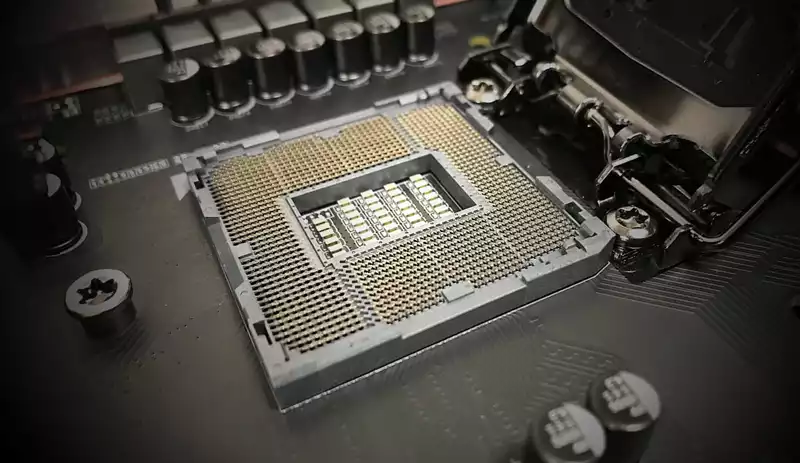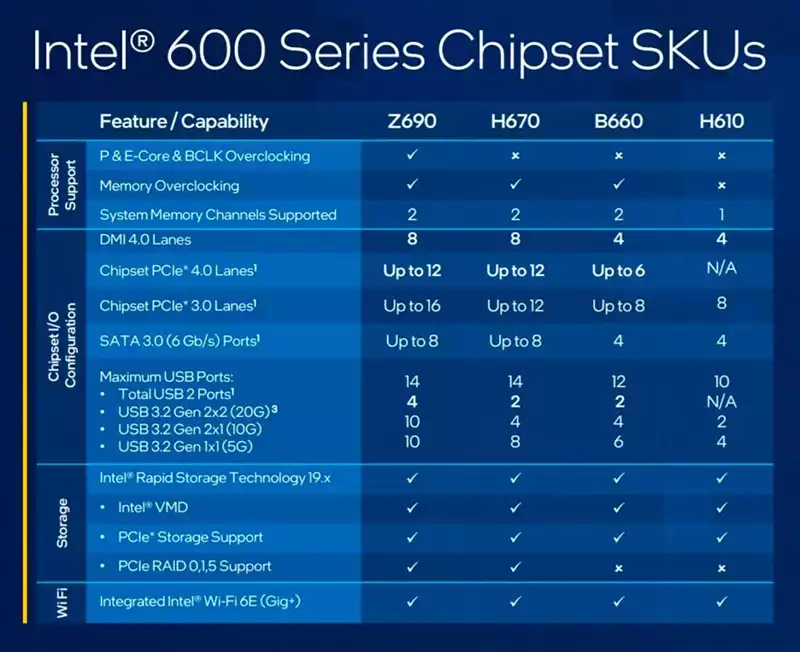You can also be interested in these:
- Z790 AORUS Tachyon full review
- Best Asus Z690 motherboards for Intel Alder Lake
- Intel Z690 vs Z590: comparative in-depth analysis
- Comparison of the Z790 and Z690 Intel motherboard chipsets
The whole 12th Gen gamut from Intel is available with the chipsets Z690, H670, B660 and H610. Now we have at our disposal the complete line-up of motherboards products for the Intel Alder Lake processors. Now, here comes the question: Isn’t it enough to buy a more or less powerful version of the CPU for low and high-end configurations? The answer is: Not necessarily. The capabilities of each motherboard can be extended significantly to enable more hardware features. For instance, the most powerful Alder Lake chipset is currently the Z690.

The chipset will indicate what type of CPU the motherboard will be able to take. The naming convention used for these chipset models is the same Intel has been using in past years. Therefore, if you already know this, it won’t be an issue stablishing what are the differences between one or another.
To that effect, the reference “Z” in the name of the chipset will always define the most advanced, and the one that normally has the ability to overclock the CPU. On the other hand, the H670 and B660 are intermediate options, while the last link on the chain is the H610, which represents the most basic option.
Common Intel chipsets features
Before talking about the discrepancies of all the Intel 12th Gen chipsets, let’s first stablish a common ground between them all: It will be easier for us defining the differences once we get to know the similarities. One of the main common features is the compatibility with any Intel 12th Gen processors, providing it is an actual desktop processor.
As of the date of this writing these are the Intel processors compatible with the Z690, H670, B660 and H610:
- Intel Core i9-12900K
- Intel Core i9-12900KF
- Intel Core i7-12700K
- Intel Core i7-12700KF
- Intel Core i5-12600K
- Intel Core i5-12600KF
- Intel Core i9-12900
- Intel Core i9-12900F
- Intel Core i7-12700
- Intel Core i7-12700F
- Intel Core i5-12600
- Intel Core i5-12500
- Intel Core i5-12400
- Intel Core i5-12400F
- Intel Core i3-12300
- Intel Core i3-12100
- Intel Pentium Gold G7400
- Intel Celeron G6900
- Intel Core i9-12900T
- Intel Core i7- 12700T
- Intel Core i5-12600T
- Intel Core i5-12500T
- Intel Core i5-12400T
- Intel Core i3-12100T
- Intel Pentium Gold G7400T
- Intel Celeron G6900T.
In you want to see the complete list of compatible Alder Lake processors you can go to the official Intel website.
An interesting question that is not currently clear is whether or not these chipsets will get support for future generation CPUs. Everything seems to indicate they will. In the rapid response due to the market pressure Intel announced the release of its 13th generation which will share the same chipsets as Alder Lake’s. Hopefully we will also see a 14th generation developed using the same technology, although this is not likely at all.

In terms of connectivity there are also a few common features. For instance, the support with Intel VMD technology and Intel Rapid Storage Technology. Additionally, all boards will come with support for the next Gen Intel 6E WiFi natively. This doesn’t mean every motherboard will come with the WiFi functionality integrated. Instead, it refers to the potential to be integrated by manufacturers built on their architecture. Having said that, we can predict a significant number of motherboards models with integrated WiFi connectivity.
We have detailed on another article the difference between the DDR4 and DDR5 memories. It just so happen the motherboards chipsets Z690, H670, B660 and H610 will be able to accept either one or another. This factor will be common for all aforementioned chipsets as long they have the LGA 1700 socket.
Differences between the Z690, H670, B660 and H610 chipsets
Having evaluated the similitudes, now let’s talk about the most important aspects that differ from one chipset to another.
Memory overclocking and CPU
The only chipset that supports overclocking at this moment is the Z690 chipset. It affects both Efficiency cores and performance cores. This is also the only chipset supporting BCLK overclocking. In turn, Z690 is not the only chipset supporting memory overclocking. You can also do it in the H670 and the B660. Of course, the B610 doesn’t support this.
Memory overclocking might sound like a new concept for some, but it has opened the limits of the RAM memory capacity allowing us to set them with a custom frequency of our liking through XMP profiles. The good thing about it is that we can bypass the normal JEDEC specs, which oftentimes leads to questionable performance. Added to this is the fact that now the complexity that normally involves the process of overclocking has been reduced significantly to just activating an XMP profile that will do all the heavy lifting for us.
Lastly, the H670 and Z690 motherboards will have more bandwidth to interface with the CPU and chipset, through the use of 8 DMI 4.0 lanes, in contrast with the 4 present in the B660 and H610 boards. Maybe in past years this was a problem, but now, even in the most basic configurations, the bandwidth is not that bad.
The takeaway we get from this is, if you are interested in overclocking your PC (either on a K- or KF-terminated CPU), the Z690 is the way to go. For the average user, who normally don’t mess with custom configuration (or understand it), the recommendation is getting the H670 or B660.

Storage connectivity and PCIe
PCIe 5.0 is officially available for the Alder Lake processor, but this connectivity is not reliant on the chipset, rather it is carried out by the CPU. Therefore, we will have configurations of PCIe 5.0 1 x 16, no matter what chipset we are using. On the Z960 and H670 there is compatibility with 2 x 8 configuration, which means, these are the go-to chipsets for dual GPU configurations.
Additionally, we will have more PCIe lanes included in the motherboard. Here lies another big difference:
- Z690 will have up to 12 PCIe 4.0 lanes, and up to 16 PCIe 3.0 lanes.
- H670 will have up to 12 PCIe 4.0 lanes, and up to 12 PCIe 3.0 lanes.
- B660 will have up to 6 PCIe 4.0 lanes, and up to 8 PCIe 3.0 lanes.
- H610 will have only 8 PCIe 3.0 lanes.
In comparison the maximum number of SATA connections a motherboard can have, depending on the chipset, is 8 SATA ports for the Z690 and H670, and 4 SATA ports in the case of the B660 and H610.
Finally in the storage section, for those interested in RAID configurations, the boards Z690 and H670 will integrate support for RAID 0, 1 and 5 through PCIe. As expected, the B660 and H610 won’t support it.
USB port availability
Another key factor that can determine an important difference in these chipsets is the number of USB connection ports that can be physically integrated in the boards, despite the technology. We have put together a table to explain better this difference:
| Z690 | H670 | B660 | H610 | |
| General maximum number of USB ports (2.0) | 14 | 14 | 12 | 10 |
| USB 3.2 Gen 2×2 (20 Gbps) | 4 | 2 | 2 | 0 |
| USB 3.2 Gen 2×1 (10 Gbps) | 10 | 4 | 4 | 2 |
| USB 3.2 Gen 1×1 (5 Gbps or 3.0) | 10 | 8 | 6 | 4 |
The Z690 chipset is rather advanced when it comes to USB peripheral connectivity, although we can get a decent connectivity layout on B660. As we have seen up until now, the major detriment in performance and features on the H610 chipset, which makes a big sacrifice in connectivity.
In short, even if we decide to go with the more advanced model, the Z690, if it reaches the maximum capacity of the USB technology it can have, the rest will be filled with USB 2.0. For example, if we have a Z690 motherboard with 14 USB ports with the following distribution:
- 2 USB Gen 2×2
- 5 USB 3.2 Gen 2×1
- 5 USB 3.2 Gen 1×1
The total USB for this case is 12. Therefore, the remaining 2 USB connectors will be 2.0. There is a valuable lesson here: a higher tier motherboard doesn’t necessarily mean you are buying a better product. You may face the reality you never get to use those extra 2.0 USB ports, which by the way, you paid extra for.
Closing remarks: What is the best chipset for me?
Intel has just announced the launch of the H670, B660 and H610 chipsets at the CES 2022. With these, along with the Z690 chipset, the whole Intel Alder Lake line-up is now complete. Actually the decision of what chipset is more in line with my needs is a no brainer. It all comes down to how much we are going to be willing to expend.
As we have already stated, the Z690 motherboards has the most powerful and interesting features for the more demanding requirements, but it comes with a premium. With this board, we will get the most out of this new CPU technology, lots of peripheral connectivity and the ability to overclock our CPU.
In the mid-range level, we have the H670 and B660 chipsets. These boards are quite powerful as well, even for gaming needs. These are the perfect balance in value proposition for tighter budgets. The H610 on the other hand is quite limiting and presents a significant reduction in features, even for its price point.
More stories like this
- Z790 AORUS Tachyon full review
- Best Asus Z690 motherboards for Intel Alder Lake
- Intel Z690 vs Z590: comparative in-depth analysis
- Comparison of the Z790 and Z690 Intel motherboard chipsets
- Intel B760 vs B660 chipset: Features and differences
- Which Intel CPU works best with liquid cooling?